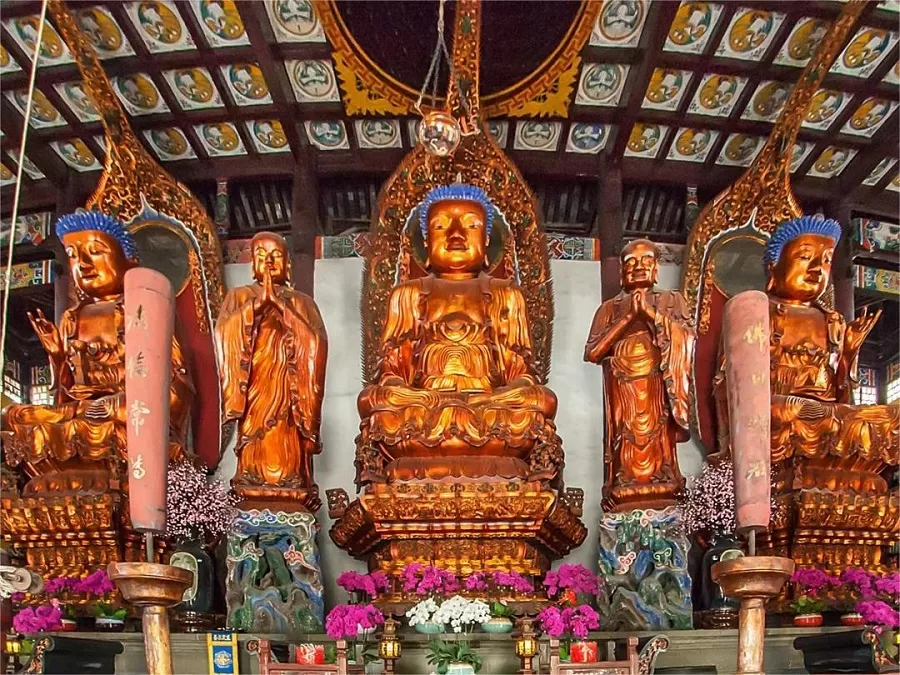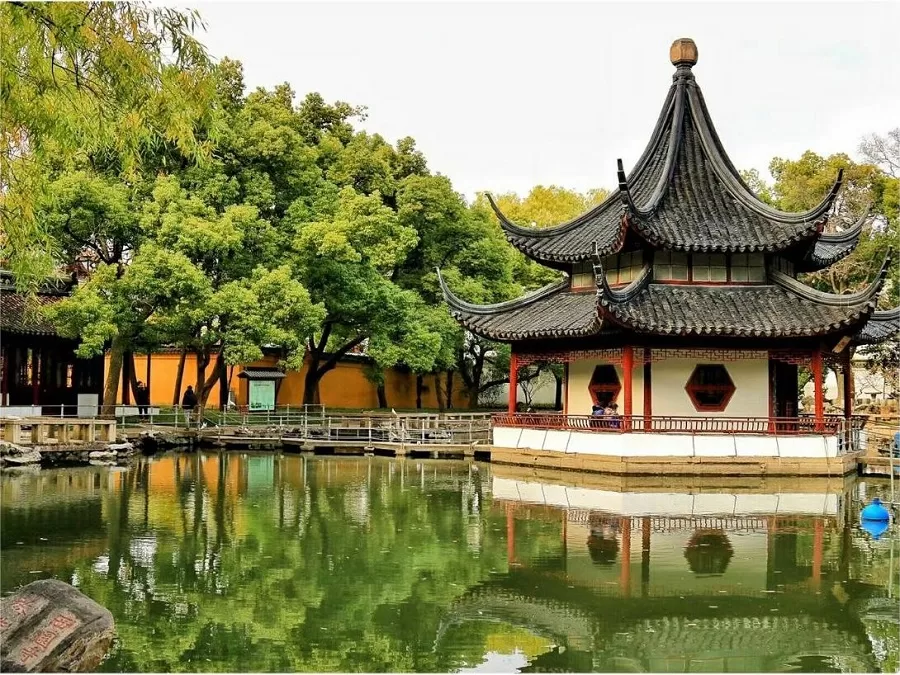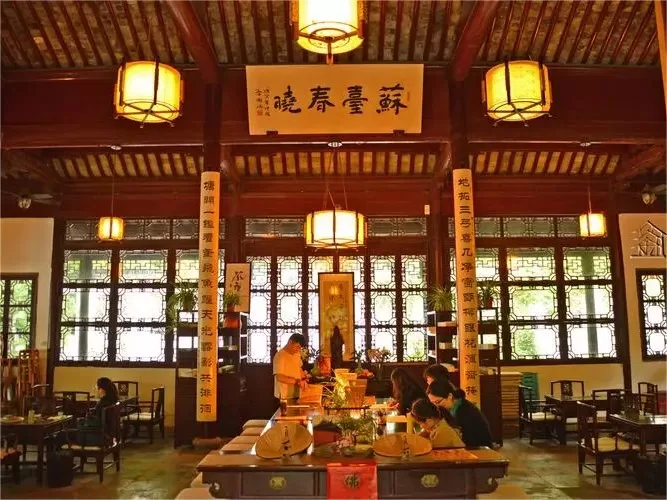XiYuan Temple, also known as West Garden Temple (西园寺), nestled in the picturesque city of Suzhou, China, is a timeless sanctuary that weaves spirituality and history together. This Buddhist temple, with its origins tracing back to the Yuan Dynasty, exudes an aura of tranquility amid the bustling urban landscape. The temple’s architecture, characterized by delicate pavilions, intricate sculptures, and serene courtyards, showcases the beauty of traditional Chinese craftsmanship.
XiYuan Temple’s allure lies not only in its architectural grandeur but also in its profound cultural significance. As a haven for meditation and reflection, it offers visitors an escape from the modern world into a realm of serenity. The fragrant incense, rustling leaves, and softly chiming bells create an atmosphere conducive to inner harmony and contemplation.
Steeped in history, XiYuan Temple stands as a testament to Suzhou’s rich heritage, inviting both pilgrims and tourists to experience a peaceful interlude in the midst of the city’s vibrant energy. It remains a living embodiment of China’s spiritual and architectural legacy, a cherished gem that continues to inspire and uplift all who venture within its sacred grounds.
Table of Contents
- Basic Information
- Location and Transportation
- Highlights of Xiyuan Temple
- Vlog about Xiyuan Temple
- Useful Tips Summarized from Reviews
- Attractions near Xiyuan Temple
Basic Information
| Estimated Length of Tour | 1 – 2 hours |
| Ticket Price | 50 RMB |
| Opening Hours | 8.00 – 17.00; Last admission: 16.30 |
| Area | 49670 square meters |
| History | 1264 – 1294: Initially built and named as Guiyuan Temp (归元寺) 1522 – 1566: Converted into residence by Xu Tai (徐泰) and reconverted into a temple by his son, Xu Rong (徐溶), after his death 1860: Destroyed in a war 1871 – 1908: Rebuilt by Monk Master Guanghui (广惠) 1962 – 1980: Protected by Monk Master Mingkai (明开) and survived the Cultural Revolution 1980 – 1991: Renovated, decorated, and expanded |
| Telephone Number | 0086-0512-65349545 |
Location and Transportation
XiYuan Temple is situated in the heart of Suzhou, a city renowned for its classical gardens and cultural heritage in Jiangsu Province, China. This tranquil Buddhist temple offers a serene escape from the city’s hustle and bustle, inviting visitors to immerse themselves in its peaceful ambiance. Its exact address is No. 18, Xiyuan Alley, Liuyuan Road, Gusu District. To get there, you can choose the following ways:
Bus: Take bus 34, 40, 311, 400, or 933, get off at Xiyuan Road East Stop (西园路东), and you will be standing at the north side of the temple.
Metro: The nearest metro station to Xiyuan Temple is Shilu (石路) on line 2. After getting out of the station from Exit 1, take bus 406 or walk to cover the remaining 1.3 kilometers.
Highlights of Xiyuan Temple
Architectural Marvels

The architecture of Xiyuan Temple in Suzhou showcases a serene marvel. A 13.9-meter-wide and 5-meter-tall screen wall welcomes visitors, adorned with intricate designs. The main hall, crafted during the Guanxu reign of the Qing Dynasty, stands as a masterpiece of ancient craftsmanship. Its historical significance intertwines with the impressive bell tower and drum tower, echoing tales of spiritual resonance and cultural heritage. This harmonious ensemble captures the essence of China’s rich architectural tradition and invites contemplation amid the beauty of Suzhou’s historical legacy.
Precious Relics

XiYuan Temple houses a captivating array of Buddhist relics, each carrying a unique historical and spiritual significance. These artifacts include intricately carved statues of Buddhas and bodhisattvas, encapsulating the essence of devotion and enlightenment. Ancient scriptures, delicate thangka paintings, and ritual implements provide insights into the temple’s profound religious heritage. These relics not only serve as cultural treasures but also offer a tangible connection to the temple’s rich past. Exploring XiYuan Temple’s relics unveils a journey through time and devotion, inviting visitors to delve into the depths of Buddhist tradition and the enduring legacy of Suzhou’s spiritual tapestry.
Main Hall

The main hall of XiYuan Temple stands as a serene sanctuary, embodying the heart of spiritual devotion. Adorned with resplendent Buddha statues and intricate carvings, the hall exudes an air of tranquility and reverence. Its architectural grandeur, characterized by traditional Chinese design elements, offers a visual feast for the senses. Stepping into the hall, visitors are enveloped in an aura of contemplation and meditation, as the delicate interplay of light and shadows dances upon sacred surfaces. The main hall serves as a gateway to inner reflection, inviting all to experience the profound essence of XiYuan Temple’s spiritual journey.
Lush Gardens and Huxin Pavilion

Nestled within Xiyuan Temple in Suzhou, a captivating garden unfolds around a tranquil pavilion poised at the center of a picturesque lake. The garden, a testament to refined aesthetics, merges natural beauty with deliberate design. Blossoming flora and meandering pathways create a serene ambiance, inviting contemplation and respite. The pavilion, seemingly suspended over the water’s surface, exudes an air of elegance. With its intricate architectural details and harmonious proportions, it stands as a symbol of architectural artistry and spiritual harmony, offering a haven for reflection and connection to nature’s splendor amidst the temple’s sacred surroundings.
Teahouse Experience

Nestled within the sanctuary of XiYuan Temple, the teahouse presents a serene fusion of cultural immersion and relaxation. Adorned with traditional décor, it offers a tranquil space where visitors can savor authentic Chinese teas while enveloped in the temple’s spiritual ambiance. The teahouse experience transcends taste, serving as a bridge between ancient traditions and modern moments. As fragrant steam rises from delicate cups, conversations meld with the temple’s whispers, creating a harmonious blend of past and present.
Vlog about Xiyuan Temple
Useful Tips Summarized from Reviews
Vegetarian Noodles at Tianwang Hall (天王殿):
- Try the vegetarian noodles located on the left side of Tianwang Hall.
- Available from 8:00 to 15:00, prices generally range from 10 to 20 yuan.
- Various pastries are also offered alongside the noodles.
Vegetarian Buns (素包子) at the Courtyard to the Left of Gulou (鼓楼):
- Head to the courtyard to the left after turning from Gulou (Drum Tower).
- Vegetarian buns are available for 2 yuan each.
Interaction with Cats:
- Starting from the entrance, you’ll encounter many adorable cats along the way.
- Most of them are friendly and not afraid of people. You can bring cat food, but ensure safety.
- Enjoy the company of the cats, and be cautious with feeding.
Feeding Pigeons at the Lakeside in the West Garden (西花园):
- The lakeside in the West Garden has many pigeons.
- Prepare some small pieces of bread to feed the pigeons and enjoy the peaceful lakeside scenery.
Dress Code:
- Avoid wearing flip-flops or sandals.
- Clothing should not reveal shoulders, back, or be too short. Skirts and pants should ideally reach the ankles.
- Maintain modest attire respecting the cultural and religious context of the temple.
No Meat Inside the Temple:
- Do not bring meat-based food into the temple premises.
- Adhere to the vegetarian offerings and respect the temple’s guidelines regarding food.






